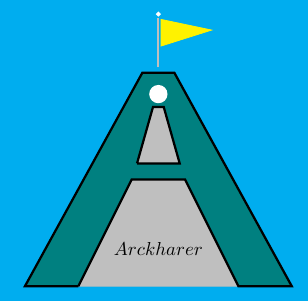Chapter 6
Conic Sections
In this chapter, we will study the basic properties and equations of circles and parabolas.
6.1 Introduction
The curves that can be obtained by the intersections of a plane with a double right-circular cone are called conics or conic sections. The cone
consists of two parts, called nappes that intersect at the vertex. The most important of conic sections or simply conics are circles, ellipses, parabolas and
hyperbolas.
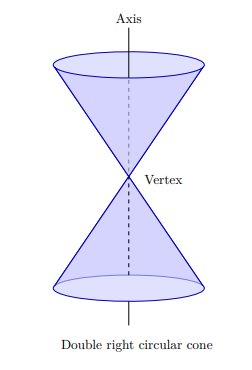
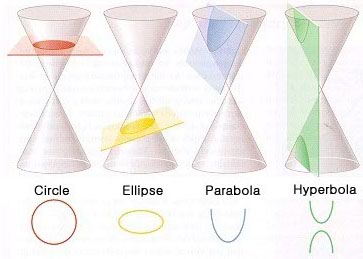
image credit
A circle is obtained by cutting a cone with a plane that is perpendicular to the axis and does not contain the vertex. If the cutting plane is tilted slightly and intersects only one nappe, the resulting intersection is an ellipse. If the cutting plane is tilted still further so that it is parallel to a line on the surface of a cone, but intersects only one nappe, the resulting intersection is a parabola. Finally, if the plane intersects both nappes, but does not contain the vertex, the resulting intersection is a hyperbola.
All conics can be written in the form of the equation
Ax2 + Bxy + Cy2 + Dx + Ey + F = 0.
The equation of each of these conics can be written in a standard form which can tell the different types of conics without having to graph it.
Today, properties of conic sections are used in the construction of telescopes, radar antennas, medical equipment, navigational systems, and in the determination of satellite orbits.
6.2 Circles
A circle is the set of all points in a plane that are equidistant from a fixed point. the fixed point is called the center of the circle and the equidistant is called the radius of the circle.Now, we consider a circle with a radius r and the center (h, k).
Standard Form of the Equation of a Circle
If (h, k) is a fixed point in the plane, then the circle of radius r centered at (h, k) is the set of all points in the plane whose distance from (h, k) is r.Thus, a point (x, y) will lie on this circle if and only if
$$\small{\sqrt{(x-h)^2 + (y-k)^2} = r \qquad (1)}$$ or equivalently,
(x - h)2 + (y - k)2 = r2 (2)
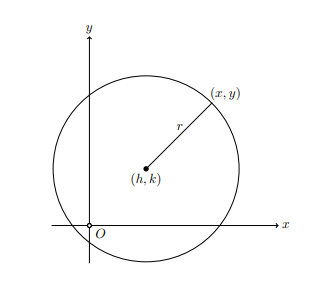
This is called the standard form of the equation of a circle. We can find immediately the center and radius from the equation.
The center = (h, k) and the radius = r.
General Form of the Equation of a Circle
Expanding the equation 2, we getx2 + y2 - 2hx - 2ky + h2 + k2 - r2 = 0
Taking 2g = - 2h, 2f = -2k, c = h2 + k2 - r2, the equation becomes the form
x2 + y2 + 2gx + 2fy + c = 0
This is called the general form of the equation of the circle.
We consider the conic equation
Ax2 + Bxy + Cy2 + Dx + Ey + F = 0.
If A = C and B = 0, the equation becomes a circle equation.
Note that B = 0 means that the equation does not contain the term xy. Again, we can find the center and radius of this equation by using the technique of completing the squares.
x2 + y2 + 2gx + 2fy = -c
x2 + 2gx + g2 + y2 + 2fy + f2 = g2 + f2 - c
(x + g)2 + (y + f)2 = g2 + f2 - c
In this case, the center is (-g, -f) and the radius is
$$\small{\sqrt{g^2 + f^2 - c}.}$$
Degenerate Cases of a Circle
Consider the equationx2 + y2 + 2gx + 2fy + c = 0
Example 1.
Find the equation of the circle radius 4 centered at (-1, 2) in standard form.
Solution
Since r = 4,
(h - k) = (-1, 2), the equation of the circle is
(x + 1)2 + (y - 2)2 = 42
(x + 1)2 + (y - 2)2 = 16.
Example 2.
Find an equation of the circle with center (-1, 2) that passes through (3, -1).
Solution
Since (h, k) = (-1, 2), (x1, y1) = (3, -1) , we have
$$\small{ r = \sqrt{(-1 - 3)^2 + (2 + 1)^2} = 5.}$$
Thus, the equation of the circle is
(x + 1)2 + (y - 2)2 = 52
x2 + y2 + 2x - 4y - 20 = 0.
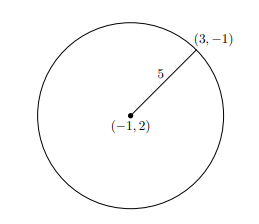
Example 3.
Find the center and radius of each of the following circles.
(a) (x - 3)2 + (y - 5)2 = 16
(b) (x + 7)2 + (y - 2)2 = 9
(c) x2 + y2 = 1
(d) x2 + (y - 3)2 = 49
Solution
| Equation of Circle | Center (h, k) | Radius r |
| (x - 3)2 + (y - 5)2 = 16 | (3, 5) | 4 |
| (x + 7)2 + (y - 2)2 = 9 | (-7, 2) | 3 |
| x2 + y2 = 1 | (0, 0) | 1 |
| x2 + (y - 3)2 = 49 | (0, 3) | 7 |
Example 4.
Find the center and radius of the following circles.
(a) x2 + y2 - 2x + 10y + 23 = 0
(b) 2x2 + 2y2 - 24x + 47 = 0
Solution
(a) Method 1
x2 + y2 - 2x + 10y + 23 = 0
x2 - 2x + y2 + 10y = -23
x2 - 2x + 12 + y2 + 10y + 52 = 1 + 25 - 23
(x - 1)2 + (y + 5)2 = 3
Therefore, the center = (1, -5) and radius = √ 3
Method 2
x2 + y2 - 2x + 10y + 23 = 0
Comparing with
x2 + y2 + 2gx + 2fy + c = 0,
we get
2g = -2, 2f = 10, c = 23.
and so
g = -1, f = 5, c = 23.
Therefore, the center = (-g, -f) = (1, -5) and
$$\small{ \text{radius} = \sqrt{g^2 + f^2 - c}}$$ $$\small{ \sqrt{1 + 25 - 23} = \sqrt{3}.}$$
(b) Method 1
2x2 + 2y2 - 24x + 47 = 0
x2 + y2 - 12x + 47 ⁄ 2 = 0
x2 - 12x + y2 = - 47 ⁄ 2
x2 - 12x + 62 + y2 = 36 - 47 ⁄ 2
(x - 6)2 + y2 = 25 ⁄ 2
(x - 6)2 + y2 = (5 ⁄ √ 2 )2
The center = (6, 0) and radius = 5 ⁄ √ 2 = 5 √ 2 ⁄ 2.
Method 2
2x2 + 2y2 - 24x + 47 = 0
x2 + y2 - 12x + 47 ⁄ 2 = 0
Comparing with
x2 + y2 + 2gx + 2fy + c = 0,
we get
2g = -12, 2f = 0, c = 47 ⁄ 2
and so
g = -6, f = 0
Therefore, the center = (-g, -f) = (6, 0) and
$$\small{ \text{radius} = \sqrt{g^2 + f^2 - c} = \sqrt{36 + 0 - \frac{47}{2}}}$$ $$\small{ = \sqrt{\frac{25}{2}} = \frac{5}{\sqrt{2} }= \frac{5 \sqrt{2}}{2}. }$$
Example 5.
Describe the graphs of the following equations.
(a) (x - 1)2 + (y + 4)2 = -9
(b) (x - 1)2 + (y + 4)2 = 0
(c) x2 + y2 - 4x + 2y - 44 = 0
Solution
(a) (x - 1)2 + (y + 4)2 = -9
We see that the right hand side is less than zero, so the equation has no graph.
(b) (x - 1)2 + (y + 4)2 = 0
The graph is a single point (1, -4).
(c) x2 + y2 - 4x + 2y - 44 = 0
Comparing with
x2 + y2 + 2gx + 2fy + c = 0,
we get
2g = -4, 2f = 2, c = -44,
and so
g = -2, f = 1, c = -44.
Since g2 + f2 - c = 4 + 1 + 44 = 49 > 0,
the graph is a circle with center at (2, -1) and radius is 7.
Exercise 6.1
1. Find the center and radius of each circle:
(a) x2 + y2 = 16
(b) (x - 1)2 + (y - 4)2 = 25
(c) (x - 3)2 + (y + 5)2 = 49
(d) (x + 1)2 + y2 = 1
(e) 2x2 + 2y2 - 12x + 8y - 24 = 0
(f) x2 + y2 + x + y -
1 ⁄ 2 = 0
2. Find the standard equation of the circle satisfying the given conditions.
(a) center(3, -2), radius = 4.
(b) center(2, 5) radius =
√
5
.
(c) center (-4, 1), radius = 3.
(d) center(-4, 8), circle is tangent to the x-axis.
(e) center(5, 8), circle is tangent to the y-axis.
(f) center(-3, -2), circle passes through the origin.
(g) center(4, -5), circle passes through (1, 3).
(h) diameter has end points (6, 1) and (-2, 3).
3. Determine whether each equation represents a circle, a point or no graph. If the equation represents a circle, find the center and radius.
(a) x2 + y2 - 6x + 2y + 9 = 0
(b) x2 + y2 - 4x - 6y + 13 = 0
(c) x2 + y2 + 10y + 26 = 0
(d) 2x2 + 2y2 - 12x + 8y - 24 = 0
(e) x2 + y2 - 10x - 2y + 29 = 0
(f) 16x2 + 16y2 + 40x + 16y - 7 = 0
(g) x2 ⁄ 4 + y2 ⁄ 4 = 1
(h) 2x2 + 2y2 + 8x + 7 = 0
6.3 The Parabola
A parabola is the set of all points (x, y) in the plane that are equidistant from a fixed line and a fixed point which is not on the fixed line.In this section, we will discuss the properties of the parabolas. The fixed line is called the directrix of the parabola and the fixed point is the focus. The line through the focus and perpendicular to the directrix is called the axis of the parabola. The point of intersection of the axis and the parabola is called the vertex. A parabola is symmetric about the axis.
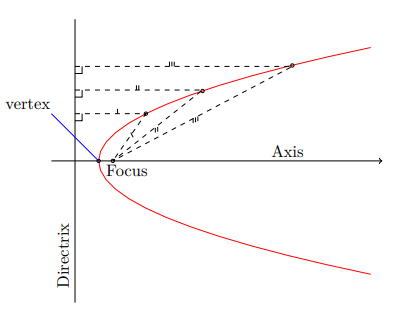
Denote the distance between the focus F and the vertex V by p. The vertex is equidistant from the focus and the directrix. Therefore, the distance between focus and directrix is 2p. As illustrated in the figure, the parabola passes through two of the corners of the box that extends from the vertex to the focus along the axis of symmetry and extends 2p units above and 2p units below the axis of symmetry. The line segment passes through the focus and is parallel to the directrix is called the latus rectum. The end points of the latus rectum lie on the curve.
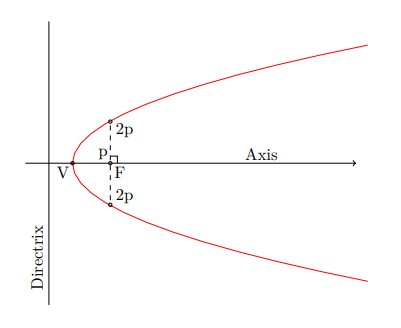
General Form of the Equation of a Parabola
From the general form of the conics equation Ax2 + Bxy + Cy2 + Dx + Ey + F = 0, we begin with the case where B = 0. In this case, the term containing xy is not present and it becomesAx2 + Cy2 + Dx + Ey + F = 0.
Furthermore, one of A and C equals 0 becomes a parabola. We have already discussed the procedure for identifying the graph of this kind of equation; we complete the squares of the quadratic expressions in x or y, or both. Then we have
Ax2 + Dx + Ey + F = 0
or
Cy2 + Dx + Ey + F = 0.
Above two equations are called the general forms of equation of a parabola. We have learned that the graph of the quadratic function y = ax2 + bx + c, a ≠ 0 is a parabola. If a > 0, the graph opens up and otherwise, it opens down.
Equations of a Parabola: Vertex at (0, 0)
The equation of a parabola is simplest if the coordinate axes are positioned so that the vertex is at the origin and the axis is along the x-axis or y-axis.We will derive the equation for the parabola. Let P(x, y) be any point on the parabola. Since P is equidistant from the focus F(p, 0) and D(-p, y) is the foot of the perpendicular from P to the directrix, where p > 0, we have PF = PD.
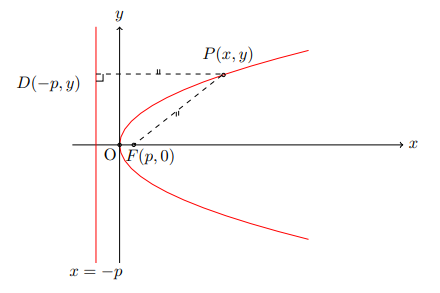
By the distance formula,
$$\small{ PF = \sqrt{(p - x)^2 + (0 - y)^2},}$$ $$\small{ PD = \sqrt{(-p - x)^2 + (y - y)^2}.}$$ Since PF = PD, we have
$$\small{\sqrt{(p - x)^2 + (0 - y)^2} = \sqrt{(-p - x)^2 + (y - y)^2}}$$ p2 - 2px + x2 + y2 = p2 + 2px + x2
y2 = 4px.
The four possible orientations are shown in the following figures. These are called the standard forms of equation of a parabola.
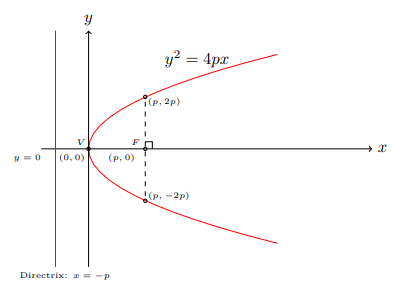
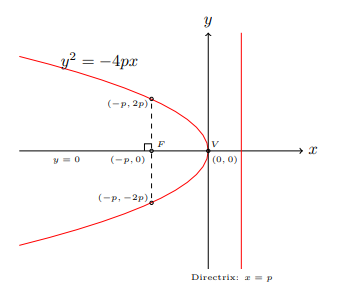
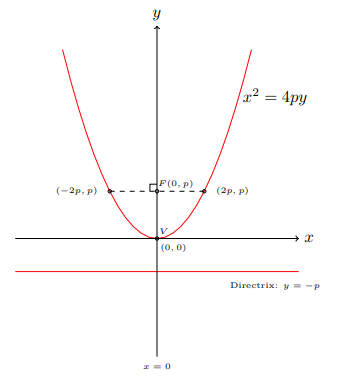
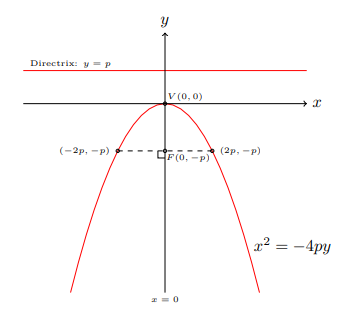
Equations of a parabola:
Vertex at (0, 0) , Focus on Coordinate Axis, p > 0
| Equation | Vertex | Focus | Directrix | Axis of Symmetry | Description |
| y2 = 4px | (0, 0) | (p, 0) | x = -p | horizontal axis, y = 0 | opens to the right |
| y2 = -4px | (0, 0) | (-p, 0) | x = p | horizontal axis, y = 0 | opens to the left |
| x2 = 4py | (0, 0) | (0, p) | y = -p | vertical axis, x = 0 | opens up |
| x2 = -4py | (0, 0) | (0, -p) | y = p | vertical axis, x = 0 | opens down |
Parabolas can be graphed by using the following four steps :
- opens to the right if the coefficient of x is positive.
- opens to the left if the coefficient of x is negative.
- opens up if the coefficient of y is positive.
- opens down if the coefficient of y is negative.
Using the above facts, sketch the parabola so that its vertex is at the origin and it passes through the corners of the box.
Example 6.
Sketch the graphs of the parabolas, showing the vertex, focus, directrix and end points of latus rectum of each equation.
(a) x2 = 16y (b) y2 + 8x = 0
Solution
(a) x2 = 16y
Comparing with x2 = 4py, we get p = 4.
Therefore, the vertex V = (0, 0), the focus F = (0, 4), the directrix is y = -4 and end points of latus rectum are (-8, 4), (8, 4).
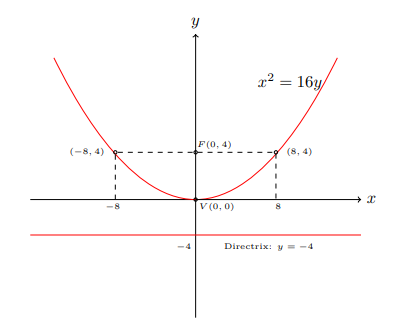
(b) y2 + 8x = 0
y2 = -8x
Comparing with y2 = -4px, we get p = 2.
Therefore, the vertex V = (0, 0), the focus F(-2, 0), the directrix is x = 2 and end points of latus rectum are (-2, -4), (-2, 4).
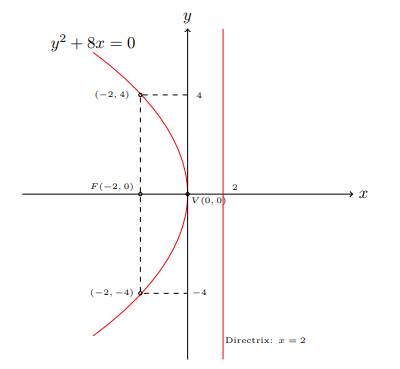
Example 7.
Find an equation of the parabola that is symmetric about the y-axis with its vertex at the origin, and passes through (5, 2).
Solution
Since the parabola is symmetric about the y-axis, the vertex V = (0, 0) and passes through (5, 2), the equation of the form is
x2 = 4py
52 = 4p(2)
4p = 25⁄2.
Therefore, the equation of the parabola is
x2 = 25⁄2y.
In Exercise 1 - 8, (a) sketch the parabola, (b) show the focus, vertex, directrix and end points of latus rectum.
1. y2 = 8x
2. y2 = -6x
3. x + y2 = 0
4. y = x2
5. y = -x2
6. y = 3x2
7. y = -3x2
8. x2 + 6y = 0
In Exercise 9 - 16, find an equation for the parabola satisfying the given conditions.
9. Vertex (0, 0), focus (3, 0).
10. Vertex (0, 0), focus (0, -4)
11. Vertex (0, 0). directrix x = 7.
12. Vertex (0, 0), directrix y = 1 ⁄ 2.
13. Focus (0, -3), directrix y = 3.
14. Focus (6, 0), directrix x = -6
15. Vertex (0, 0); symmetric about the x-axis; passes through (2, 2).
16. Vertex (0, 0); symmetric about the y-axis; passes through (-1, 3).
Translation of Axes
If a parabola with vertex at the origin and axis of symmetry along a coordinate axis is shifted horizontally h units and then vertically k units, then we get the parabola with vertex at (h, k) and axis of symmetry parallel to a coordinate axis.In the figure, a new x'y'-coordinate system appears with the origin O' at the point (h, k).
A point P in the plane has both (x, y) coordinates and (x', y') coordinates.
In the figure, their coordinates are related by x' = x - h, y' = y - k or equivalently,
x = x' + h, y = y' + k.
These are called Translation equations
As an example, if a new origin is (h, k) and the xy-coordinates of the point P are (2, 5), then the x'y'-coordinates of P are
x' = x - h = 2 - 4 = -2 and
y' = y - k = 5 - (-1) = 6 .
Therefore the new coordinates of the point is (-2, 6).
Translated Parabola
Now we can consider a parabola with vertex V at (h, k) in any xy-coordinate system and axis of symmetry parallel to the y-axis. If we translate the axis, the vertex V will be at the origin of an x'y'-coordinate system.
Parabola with Vertex (h, k) and Axis parallel to y-axis
In x'y'-coordinates, the equation of the parabola will be
(x')2 = 4py' or (x')2 = -4py' (See the figure).
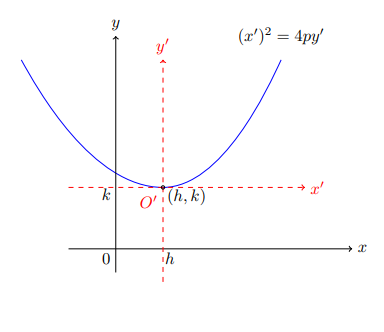
The corresponding equation in xy-coordinates will be
(x - h)2 = ±4p(y - k).
Here the (+) sign occurs if the parabola opens in the positive y direction and the (-) sign occurs if the parabola opens in the negative y directioin.
Parabola with Vertex (h, k) and Axis parallel to x-axis
The equation of the parabola with vertex (h, k) and axis parallel to x-axis is of the form
(y - k)2 = ±4p(x - h).
Here the (+) sign occurs if the parabola opens in the positive x direction and the (-) sign occurs if the parabola opens in the negative x direction.
The four possible such orientations whose vertices not at the origin are shown in the following figures. These are called the standard positions of a parabola, and the resulting equations are called the standard forms of equation of a parabola.
Equations of a Parabola:
Vertex at (h, k), Parallel to Coordinate Axis, p>0
| Equation | Vertex | Focus | Directrix | Axis of Symmetry |
Description |
| (y - k)2 = 4p(x - h) | (h, k) | (h+p, k) | x = h - p | horizontal axis, y = k |
opens to the right |
| (y - k)2 = -4p(x - h) | (h, k) | (h-p, k) | x = h + p | horizontal axis, y = k |
opens to the left |
| (x - h)2 = 4p(y - k) | (h, k) | (h, k+p) | y = k - p | vertical axis, x = h |
opens up |
| (x - h)2 = -4p(y - k) | (h, k) | (h, k-p) | y = k + p | vertical axis, x = h |
opens down |
Example 8.
Write the given equation y2 - 12x - 6y - 3 = 0 in standard form. Sketch its graph showing the vertex, focus, directrix and end points of latus rectum.
Solution
y2 - 12x - 6y - 3 = 0
y2 - 6y = 12x + 3
y2 - 6y + 32 = 12x + 3 + 9
(y - 3)2 = 12x + 12
(y - 3)2 = 12(x + 1)
Comparing with (y - k)2 = 4p(x - h), we have h = -1, k = 3 and p = 3.
Therefore, the vertex V = (-1, 3), the focus F = (2, 3) and the directrix is x = -4.
Example 9.
Write the given parabola equation x2 - 2x + 8y - 23 = 0 in standard form. Sketch its graph showing the vertex, focus, directrix and endpoints of latus rectum.
Solution
x2 - 2x + 8y - 23 = 0
x2 - 2x = -8y + 23
(x - 1)2 = -8y + 24
(x - 1)2 = -8(y - 3)
Comparing with (x - h)2 = -4p(y - k), we have h = 1, k = 3 and p = 2.
Therefore, the vertex V = (1, 3), the focus F = (1, 1) and the directrix is y = 5.
Example 10.
Find the standard form of the equation of the parabola with vertex (1, 2) and focus at (4, 2).
Solution
Since the focus and vertex are on a horizontal line and the focus is on the right of the vertex, the parabola opens to the right.
The vertex V = (1, 2) , the focus F = (4, 2) = (1+3, 2).
Therefore h = 1, k = 2 and p = 3.
The equation of the parabola is
(y - k)2 = 4p(x - h)
(y - 2)2 = 4 × 3(x - 1)
(y - 2)2 = 12(x - 1)
Example 11.
Find the general form of the equation of the parabola with vertex (2, 1) and focus (2, 4).
Solution
Since the focus and vertex are on a vertical line and the focus is above the vertex, the parabola opens up.
Then V = (h, k) = (2, 1), F = (2, 4) = (2, 1+3) and p = 3.
The equation of the parabola is
(x - h)2 = 4p(y - k)
(x - 2)2 = 4 × 3(y - 1)
x2 - 4x + 16 = 12y
x2 - 4x - 12y + 16 = 0.
The general form of the parabola is x2 - 4x - 12y + 16 = 0.
In Exercise 1 - 6, (a) sketch the parabola, (b) show the focus, vertex, directrix and end points of latus rectum.
1. x2 + 4x + 4y = 0
2. (x - 1)2 + 8(y + 1) = 0
3. (x + 5) + (y - 1)2 = 0
4. y2 + 6y + 8x + 25 = 0
5. x2 + 4x + 6y - 2 = 0
6. y2 + x + y = 0
In Exercise 7 - 14, find an equation for the parabola satisfying the given conditions.
7. Vertex (4, -5),
Focus (1, -5)
8. Vertex (5, 1)
focus (5, 3)
9. Vertex (1, 1),
directrix y = -2.
10. Vertex (2, -1). directrix x = -1.
11. Focus (-1, 4), directrix x = 5.
12. Focus (6, 0), directrix x = -6.
13.Axis x = 0 passes through (2, -1) and (-4, 5).
14. Axis y = 0 passes through (3, 2) and (2, -3).
6.4 Rotation of Axes
In a rotation of axes, the origin remains fixed while the x-axis and the y-axis are rotated through an angle θ to a new position; the new positions of the x and y axes are denoted by x' and y', respectively as shown in figure.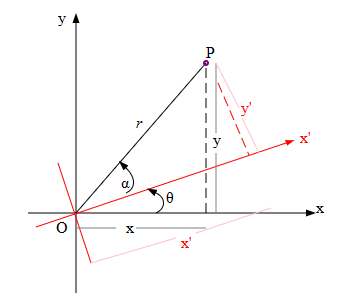
Here, the point P has the coordinates (x, y) relative to the xy-plane. We can express x and y in terms of x', y' and θ.
As in figure, r denotes the distance from the origin to the point P, and α denotes the angle between the positive x'-axis and the ray from O through P.
Then, by using definition of sine and cosine, we have
x' = r cos α, y' = r sin α,
x = r cos(θ + α), y = r sin(θ + α).
Next,
x = r cos(θ + α)
= r(cos θ cos α - sin θ sin α)
= (r cos α)(cos θ) - (r sin α)(sin θ)
= x' cos θ - y' sin θ
Similarly,
y = r sin(θ + α)
= r(sin θ cos α + cos θ sin α)
= (r cos α)(sin θ) + (r sin α)(cos θ)
= x' sin θ + y' cos θ
Now we have the following theorem.
Theorem
If the x and y axes are rotated through an angle θ, then the coordinates (x, y) of a point P relatively to the xy-plane and the coordinates (x' , y') of the same point relative to the new x' and y' axes are related by the formulax' = x cos θ + y sin θ
y' = -x sin θ + y cos θ.
Proof:
We have the rotation equations:
x = x' cos θ - y' sin θ
y = x' sin θ + y' cos θ.
Multiplying with sin θ and cos θ to the respective rotation equations gives:
x sin θ = x' sin θ cos θ - y' sin2 θ (1)
y cos θ = x' sin θ cos θ + y' cos2 θ (2)
Solving equations (1) and (2)
y' = -x sin θ + y cos θ
Multiplying with cos θ and sin θ to the respective rotation equations gives:
x cos θ = x' cos2 θ - y' sin θ cos θ (3)
y sin θ = x' sin2 θ + y' sin θ cos θ (4)
Adding equations (3) and (4) gives
x' = x cos θ + y sin θ
So, we have the formulas
x' = x cos θ + y sin θ
y' = -x sin θ + y cos θ.
Example 12
Find the new coordinates of the point (1, 2) if the coordinate axes are rotated through an angle of θ = 30°
Solution
We have x = 1, y = 2,
cos θ = cos 30° = √ 3⁄2,
sin θ = sin 30° = 1⁄2
Then
x' = x cos θ + y sin θ
x' = 1( √ 3⁄2) + 2(1⁄2)
= √ 3⁄2 + 1
y' = - x sin θ + y cos θ
y' = -1(1⁄2) + 2( √ 3⁄2)
= - 1⁄2 + √ 3.
Therefore, the new coordinates are ( √ 3⁄2 + 1, - 1⁄2 + √ 3)
Eliminating the x'y'-Term
We have the general equationAx2 + Bxy + Cy2 + Dx + Ey + F = 0
with B ≠ 0.
We substitute
x = x' cos θ - y' sin θ and
y = x' sin θ + y' cos θ
in the general equation, then
A'(x')2 + B'x'y' + C'(y')2 + D'x' + E'y' + F' = 0
where
A' = A cos2 θ + B cos θ sin θ + C sin2 θ,
B' = B(cos2 θ - sin2 θ) + 2(C - A) sin θ cos θ,
= B(cos 2θ) - (A - C) sin 2θ,
C' = A sin θ - B sin θ cos θ + C cos2 θ,
D' = D cos θ + E sin θ,
E' = -D sin θ + E cos θ,
F' = F.
To eliminate the x'y'-term, choose θ such that B' = 0.
So
B(cos 2θ) - (A - C) sin 2θ = 0
cot 2θ = A - C⁄B.
Note
1. If cot 2θ = 0, then 2θ = 90° so that θ = 45° .
2. If cot 2θ ≠ 0, first find cos 2θ to obtain the correct acute angle θ.
Then we have
We can prove that
B'2 - 4A'C' = B2 - 4AC,
and since B' = 0, we have
B2 - 4AC = - 4A'C' .
If B2 - 4AC = 0, then -4 A'C' = 0 and we have
A' = 0 or C' = 0.
When A' = 0, C'y'2 + D'x' + E'y' + F' = 0.
When C' = 0, A'x'2 + D'x' + E'y' + F' = 0.
This means that if B2 - 4AC = 0, after rotation with θ, then the general equation Ax2 + Bxy + Cy2 + Dx + Ey + F = 0 becomes the standard form of the equation of a parabola.
The rotation of the coordinate axes through an angle θ transforms the equation
Ax2 + Bxy + Cy2 + Dx + Ey + F = 0
into the form
A'(x')2 + B'x'y' + C'(y')2 + D'x' + E'y' + F' = 0
has the following rotation invariants.
1. F = F'
2. A + C = A' + C'
3. B2 - 4AC = B'2 - 4A'C'
Example 13.
Rotate the coordinate axes to remove the xy-term of the equation
3x2 - 2√ 3 xy + y2 + 2x + 2√ 3 y = 0
in x'y'-coordinate system. Then sketch the graph.
Solution
3x2 - 2√ 3 xy + y2 + 2x + 2√ 3 y = 0
Comparing with the general equation, we get
A = 3, B = -2√ 3 , C = 1.
Therefore B2 - 4AC = (-2√ 3 )2 - 4(3)(1) = 0 and
cot 2θ = A - C⁄B = 3 - 1⁄ -2√ 3 = - 1⁄ √ 3 .
Thus,
2θ = 120° and so θ = 60° .
Next,
sin θ = sin 60° = √ 3 ⁄2 and
cos θ = cos 60° = 1⁄2 .
By using x = x' cos θ - y' sin θ and
y = x' sin θ + y' cos θ, we get
x = 1⁄2x' - √ 3 ⁄2y' and
y = √ 3 ⁄2x' + 1⁄2y' .
By substituting x = 1⁄2x' - √ 3 ⁄2y' and
y = √ 3 ⁄2x' + 1⁄2y' in given equation, we get
3⁄4((x')2 - 2√ 3 x'y' + 3(y')2) - √ 3 ⁄2 (x' - √ 3 y')(√ 3 x' + y') + 1⁄4(3(x')2 + 2√ 3 x'y' + (y')2) + x' - √ 3 y' + 3x' + √ 3 y' = 0
and then
(y')2 = -x'.
We see that the new conic is a parabola with vertex (0, 0).
Example 14.
Rotate the coordinate axes to remove the xy-term of the equation
16x2 - 24xy + 9y2 + 100x - 200y + 100 = 0
in x'y'-coordinate system. Then sketch the graph.
Solution
16x2 - 24xy + 9y2 + 100x - 200y + 100 = 0
Comparing with the general equation, we get
A = 16, B = -24 , C = 9.
We find that B2 - 4AC = (-24)2 - 4(16)(9) = 0 and
cot 2θ = A - C⁄B = 16 - 9⁄-24 = - 7⁄24.
Using trigonometric identities, we see that
cos 2θ = - 7⁄25.
Therefore,
sin θ = 4⁄5 and cos θ = 3⁄5.
We get x = 3⁄5 x' - 4⁄5y' and
y = 4⁄5 x' + 3⁄5y' .
Substituting these values into the given equation, we get
25(y')2 - 100x' - 200y' + 100 = 0
(y')2 - 8y' = 4x' - 4
(y' - 4)2 = 4x' + 12
(y' - 4)2 = 4(x' + 3).
We see that the new conic in x'y'-plane is a parabola with vertex (-3, 4).
Since sin θ = 4⁄5 , we find that θ = 53.1° .
Exercise 6.4
Rotate the coordinate axes to remove the xy-term. Then sketch the graph.1. x2 + 2√ 3 xy + 3y2 + 2√ 3 x - 2y = 0
2. 9x2 - 24xy + 16y2 - 80x - 60y + 100 = 0
3. x2 - 2xy + y2 - 20x - 20y + 100 = 0
4. 16x2 + 24xy + 9y2 - 130x + 90y = 0
5. 3x2 + 2√ 3 xy + y2 - 8x + 8√ 3 y = 0
